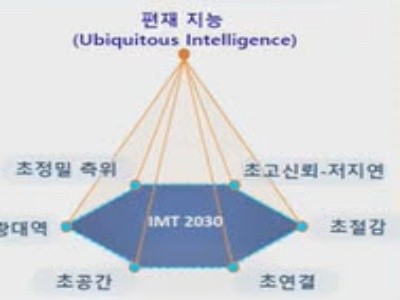Many within South Korea’s academic world believe that satellite communication and THz wave technology will play key roles in order for the country to be the leader in 6G. The academic world is currently leading global discussions about 6G technologies even from a stage of setting up key performance indicators (KPI) for R&D on 6G.
Bang Seung-cha, who is the manager at the Electronics and Telecommunications Research Institute’s Telecommunications Media Laboratory, introduced visions for 6G network at the Korean Institute of Electromagnetic Engineering and Science 2020 Summer Conference.
“6G will overcome time and spatial limitations through satellite communication, optimize itself through artificial intelligence (AI), and transform paradigms of communications.” said Manager Bang.
In order to deal with changes in paradigms, Electronics and Telecommunications Research Institute (ETRI) is going to conduct R&D based on six major visions of 6G that are super-accurate positioning, ultra-reliable and low latency , ultra-wideband, superspace, hyperconnectivity, and ultra-reduction. It explained that “ubiquitous intelligence” will be applied to each area so that networks can optimize themselves on their own.
Bang predicted that satellite communication will become important in order to achieve “superspace” that will be essential in 6G. “As low orbit satellites that are 300 km above the ground become more active, smartphones will become smaller and use both satellite and ground communications.” said Bang. “Because satellite communication is capable of providing fast mobile network with low latency for any place in the world, technologies related to satellite communication will become very important.”

He also emphasized the importance of utilizing THz waves when it comes to upgrading the performance of 5G networks.
“During the 6G era, augmented reality (AR) glasses and other high-tech devices that are still in their infant stage will become norms and cause an enormous amount of data.” said Bang. “Although it will be important to utilize new frequencies such as THz frequency in order to accommodate large amounts of data, current parts and components related to THz wave are greatly insufficient compared to parts and components related to mmWave.
Choi Seong ho, who is the project manager (PM) at the Institute for Information and Communications Technology Promotion (IITP), introduced the government’ strategies on how to push forward R&D on future wireless communications technologies so that South Korea can lead the 6G era.
“Our government is going to invest $167 million (200 billion KRW) until 2025 and develop key technologies for 6G.” said Choi. “It also established step-by-step strategies for 2026, 2027, and 2028 in order to focus on commercializing 6G.”
IITP is going to push forward ten strategies in order to achieve six major visions of 6G and it plans to preoccupy patents by applying commercialized technologies regularly starting from 2026. In addition to R&D on 6G, 6G conversion technologies such as satellite communication and quantum cryptography and communication will also be included fundamentally.
“6G is just going through a stage of establishing key features and visions which is done through international telecommunication union.” said Choi. “Our country will be able to secure leadership in many global technologies through preemptive investments and establishment of systematic measures.”
Korean Institute of Electromagnetic Engineering and Science 2020 Summer Conference was held from the 19th until the 22nd in Jeju Island. Korea Institute of Electromagnetic Engineering and Science achieved its greatest conference this summer as 899 papers were submitted by industries, universities, and research institutes.
Staff Reporter Park, Jisung | jisung@etnews.com